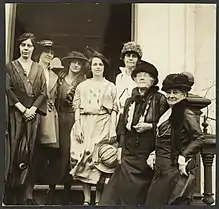Anita Pollitzer
Anita Lily Pollitzer (October 31, 1894 – July 3, 1975) was an American photographer and suffragist.
Anita Pollitzer | |
|---|---|
.jpg.webp) | |
| Born | October 31, 1894 Charleston, South Carolina |
| Died | July 3, 1975 (aged 80) New York City |
| Nationality | American |
| Education | Columbia University |
| Known for | Photography |
| Spouse(s) | Elie Charlier Edson (m. after 1928) |
Early life and education
Anita Lily Pollitzer was born October 31, 1894, in Charleston, South Carolina.[1][2] Her parents were Clara Guinzburg Pollitzer, the daughter of an immigrant rabbi from Prague,[2] and Gustave Pollitzer, who ran a cotton company at Charleston, South Carolina.[2] She had two sisters, Carrie (born 1881) and Mabel (born 1885) and a brother, Richard.
Anita was raised Jewish and, as a young woman, taught Sabbath school in Charleston at Kahal Kadosh Beth Elohim. She was later a "non-observant" Jew and relied upon her own personal strength, rather than reliance on religion. In response to her sister Mabel, who said in prayer, "God gave me mountains to climb and the strength to climb them," Anita's response was, "I don’t want God to give me mountains to climb…I want to find my own."[3]
Anita graduated from Memminger High School in 1913 and left Charleston to study art at Teachers College, Columbia University.[1][3]
Career
Artist
Pollitzer may be best known for her friendship with Georgia O'Keeffe, whom she met at Columbia University.[1] O'Keeffe mailed a set of charcoal drawings she made in 1915 to Pollitzer, who took them to Alfred Stieglitz at his 291 gallery early in 1916. Stieglitz found them to be the "purest, finest, sincerest things that had entered 291 in a long while", and in April, Stieglitz exhibited ten of her drawings at 291.[4][5] This was the beginning of one of the most significant relationships among artists in the 20th century,[1] Stieglitz promoted her career and later married O'Keeffe.[6]
Pollitzer wrote a book entitled A Woman on Paper: Georgia O'Keeffe that contained letters that she exchanged with O'Keeffe since they attended Columbia University. They remained friends until Pollitzer's death. Lynne Bundesen, who wrote a review of the book for The New York Times, said "it is a book that tells you that the voices of the most independent, far-seeing women of the times, the pioneers of women's rights and visions talked to each other as gushing, enthusiastic, eager and confused schoolgirls straight out of the Victorian era—as they may not have talked with their men." The book was published in 1988.[6]
Suffragist

Pollitzer was instrumental in the passage of the 19th Amendment and held positions of leadership in the National Woman's Party serving as National Chairman from 1945 until 1949.[1]
Personal life
In December 1928, she married Elie Charlier Edson, Pete Seeger's uncle. The couple moved to New York City and lived in an apartment on West 115th St.
She died on July 3, 1975, in New York City.[1]
References
- Nelson, Jennifer (1 March 2009). "Anita Pollitzer". Jewish Women: A Comprehensive Historical Encyclopedia. Retrieved 18 January 2015.
- "Anita Pollitzer (1894-1975): Officer and Organizer for Woman Suffrage". AmericanCivilWar.com. Retrieved 28 March 2015.
- "Anita Pollitzer". The Pollitzer Family of South Carolina. Lowcountry Digital Initiative. Archived from the original on 3 April 2015. Retrieved 28 March 2015.
- Roberts, Norma J., ed. (1988), The American Collections, Columbus Museum of Art, p. 76, ISBN 0-8109-1811-0
- Biography.com Editors (August 26, 2016). "Georgia O'Keeffe". Biography Channel. A&E Television Networks. Retrieved January 14, 2017.
- Lynne Bundesen (September 4, 1988). "The Memoir of a Legendary Friendship —A Woman on Paper — Georgia O'Keeffe by Anita Pollitzer". The New York Times. Retrieved February 1, 2017.
External links
| Wikimedia Commons has media related to Anita Pollitzer. |
- Anita Pollitzer, Library of Congress
- Anita Pollitzer biography and papers, University of South Carolina Library
- Anita Pollitzer Family Papers at South Carolina Historical Society
- Oral History Interviews with Mabel Pollitzer, Anita Pollitzer's sister and from Oral Histories of the American South